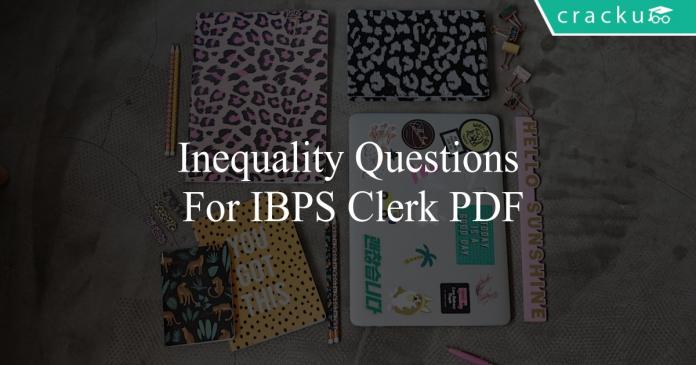Download important Para Jumble Questions PDF based on previously asked questions in IBPS Clerk and other Banking Exams. Practice Para Jumble Question and Answers for IBPS Clerk Exam.
Download Inequality Questions For IBPS Clerk PDF
105 IBPS Clerk for just Rs. 199
Take Free IBPS Clerk Mock Test
Download IBPS Clerk Previous papers PDF
Go to Free Banking Study Material (15,000 Solved Questions)
Question 1: In which of the given expressions $B>A$ is a definite true?
a) A≥D≥C>E≥B
b) B<C>F=S>A
c) E<B=C≥F<A
d) A<C≤E=D<B
e) None of these
Question 2: Which of the following symbol will replace the question mark in the given expression$ P>Q; R?S; S>P; P>T$ in order to make the expression $R<T $definitely false?
a) >
b) <
c) ≥
d) ≤
e) =
Question 3: Which of the following symbol will replace the question mark in the given expression X>Y≥Z=A?B in order to make the expression X>B definitely true?
a) >
b) <
c) ≥
d) =
e) All except (b)
Instructions
In these questions, relationship between different elements is shown in the statements which are followed by conclusions. Study the conclusions based on the given statements and select the appropriate answer.
Question 4: Statement:
D < T = Y ; N > T ≥ X ; D ≥ A = B
Conclusions:
I: B < Y
II: X < Y
a) Only Conclusion I follows
b) Only Conclusion II follows
c) Either Conclusion I or Conclusion II follows
d) Both Conclusion I and Conclusion II follow
e) Neither Conclusion I nor Conclusion II follows
Question 5: Statement:
P < T > R ; S ≥ X = M ; X ≥ T ≤ N
Conclusions:
I: N < X
II: M ≤ N
a) Only Conclusion I follows
b) Only Conclusion II follows
c) Either Conclusion I or Conclusion II follows
d) Both Conclusion I and Conclusion II follow
e) Neither Conclusion I nor Conclusion II follows
Question 6: Statement:
A > L = P ≤ B ; L < C ≤ K ; P ≥ Q = M
Conclusions:
I: K > M
II: B < C
a) Only Conclusion I follows
b) Only Conclusion II follows
c) Either Conclusion I or Conclusion II follows
d) Both Conclusion I and Conclusion II follow
e) Neither Conclusion I nor Conclusion II follows
Instructions
The following statements and conclusions have been given.Based on the statements choose the correct option as per the data provided.
Question 7: Statements: (i)9>11>12>17; 12≥10≤8
Conclusions:(i) 11≥8 (ii) 9>8
a) (i) follows
b) (ii) follows
c) Either (i) or (ii) follows
d) Both (ii) and (iii) follows
e) Neither(i) nor (ii) follows
Question 8: Statements: (i)F>D<A=E>B≤G≤C
Conclusions:(i) A≥C (ii) E<C
a) (i) follows
b) (ii) follows
c) Either (i) or (ii) follows
d) Both (ii) and (iii) follows
e) Neither(i) nor (ii) follows
Question 9: Statements: (i)A=B>C<D; C<E<FConclusions:(i) A<E (ii) D<F
a) (i) follows
b) (ii) follows
c) Either (i) or (ii) follows
d) Both (ii) and (iii) follows
e) Neither(i) nor (ii) follows
Question 10: Statements: (i)I≥M≥N>S≥P<Q=R
Conclusions:(i) M≥P (ii) I>S
a) (i) follows
b) (ii) follows
c) Either (i) or (ii) follows
d) Both (ii) and (iii) follows
e) Neither(i) nor (ii) follows
IBPS Clerk Important Questions PDF
Free Banking Study Material (15,000 Solved Questions)
Question 11: Statements: (i)A>R≥Q=F<C>G=B
Conclusions:(i) A>F (ii) A>C
a) (i) follows
b) (ii) follows
c) Either (i) or (ii) follows
d) Both (ii) and (iii) follows
e) Neither(i) nor (ii) follows
Instructions
Study the following information and answer the questions that follow:
Question 12: Which of the following should replace the question mark (?) in the given expression in order to make G > T definitely true and Y ≤ U definitely false?
J > P = U ; W ≤ Y ? X = P ; X ≤ G ; W ≥ T
a) <
b) ≤
c) =
d) >
e) ≥
Question 13: Which of the following should replace the question mark (?) in the given expression in order to make both the expressions K < B and L < P definitely false?
A > N ≤ B ; K ? C = P ; C < R < N ; L ≤ K
a) <
b) ≤
c) =
d) >
e) More than one option
Instructions
In these questions, relationship between different elements is shown in the statements which are followed by conclusions. Study the conclusions based on the given statements and select the appropriate answer.
Question 14: Statement:
W = Z < D > T ; B ≥ Y > M ; N ≤ Y = D ≥ X
Conclusions:
I: W > N
II: Z < B
III: T < X
a) Only Conclusion II follows
b) Either Conclusion I or III follows
c) Both Conclusion II and III follow
d) Only Conclusion I follows
e) All the Conclusions follow
Question 15: Statement:
A ≤ H = C < M ; L > T ≥ H ; B = A ≥ N ≤ K
Conclusions:
I: L > K
II: A < T
III: B = T
a) Only Conclusion III follows
b) Only Conclusion I follows
c) Only Conclusion I and Either Conclusion II or III follow
d) Either Conclusion II or Conclusion III follows
e) None of the Conclusions follow
Instructions
In these questions, relationship between different elements is shown in the statements which are followed by conclusions. Study the conclusions based on the given statements and select the appropriate answer.
Question 16: Statement:
W ≥ T < Q = P ; T ≥ L = O ; Q < M ≤ N
Conclusions:
I: N > W
II: P > O
III: M > L
a) Only Conclusion II is true
b) Only Conclusion III is true
c) Both Conclusions II and III are true
d) Either Conclusion I or III is true
e) None of the Conclusions are true
Question 17: Statement:
L ≥ P ≤ Q ; R = S > Q ; J > T < L
Conclusions:
I: Q < T
II: R > P
II: T ≤ Q
a) Only Conclusion II is true
b) Either Conclusion I or Conclusion III is true
c) Both Conclusion I and II are true
d) Only Conclusion II and Either Conclusion I or III is true
e) None of the Conclusions are true
Question 18: Statement:
A > E ≥ G ; B = E < F ≤ T ; L ≤ B = S
Conclusions:
I: T > A
II: S ≤ T
III: F > G
a) Only Conclusion I is true
b) Only Conclusion III is true
c) Both Conclusions I and III are true
d) Either Conclusion I or II is true
e) None of the Conclusions are true
Instructions
In these questions, relationship between different elements is shown in the statements which are followed by conclusions. Study the conclusions based on the given statements and select the appropriate answer.
Question 19: Statement:
$A < B \geq C , A = E , D \geq B , F \leq G > C$
Conclusions:
I: A > F
II: D > C
a) Only Conclusion I follows
b) Only Conclusion II follows
c) Either Conclusion I or Conclusion II follows
d) Both Conclusion I and Conclusion II follow
e) Neither Conclusion I nor Conclusion II follows
Question 20: Statement:
$L > M = N , M \leq P , R \geq L , N \geq Q$
Conclusions:
I: M > Q
II: Q = N
a) Only Conclusion I follows
b) Only Conclusion II follows
c) Either Conclusion I or Conclusion II follows
d) Both Conclusion I and Conclusion II follow
e) Neither Conclusion I nor Conclusion II follows
Daily Free Banking Online Tests
Answers & Solutions:
1) Answer (D)
From the options, we get the option (d) to be correct for making $B>A$ to be true.
2) Answer (B)
Combining the expressions we get,
$R?S>P>T$
If we put < in the above expression we get
$R<S>P>T$ that will make the$ R<T $definitely false.
3) Answer (E)
We have, $X>A $
So, any sign except ‘<‘ will fit the expression to make it true.
4) Answer (A)
The relationship between B and Y can be written as
B = A ≤ D < T = Y
Here, B is definitely less than Y.
The relationship between X and Y can be written as
X ≤ T = Y
Here, X can be either less than Y or equal to Y.
Hence, Conclusion II cannot be concluded.
Therefore, Only Conclusion I follows.
5) Answer (C)
The relationship between N and X can be written as X ≥ T ≤ N
Here, The relation cannot be established.
Since X = M, replacing X by M in the above expression,
M ≥ T ≤ N.
Here, M can be either greater than or equal to or less than N.
If we replace X by M in Conclusion I, we get both the conclusions as
N < M (or) M > N
M ≤ N.
Therefore, Either Conclusion I or Conclusion II follows.
6) Answer (A)
The relationship between K and M can be written as,
K ≥ C > L = P ≥ Q = M
Here, We can say that K is definitely greater than M.
The relationship between B and C can be written as,
B ≥ P = L < C
Here, The relationship between B and C cannot be established.
Hence, Only Conclusion I follows.
7) Answer (E)
from the statements we have ;
9>11>12≥10≤8
We don’t have the exact relation between 9 and 8 and 11 and 8 so both the statements will be false.
8) Answer (C)
from the statements we have ;
F>D<A=E>B≤G≤C
As A=E and we don’t have the exact sign between E and C so either of the statements can be true.
9) Answer (E)
from the statements we have ;
A=B>C<E<F and D>C<E<F
We don’t have the exact equality sign between A and E and D and F so both the conclusions will be false.
10) Answer (B)
from the statements we have ;
I≥M≥N>S≥P<Q=R
M>P and I>S.
So, first conclusion will be false and second will be true.
11) Answer (A)
from the statements we have ;
A>R≥Q=F<C>G=B
From the conclusion we have A>F which is true.A>C is false as equality signs are opposite or no definite sign is there.
12) Answer (A)
If we replace ? with T ≤ W ≤ Y < X ≤ G
Y < X = P = U
Here, G > T is definitely true.
Y ≤ U is definitely false.
If we replace ? with ≤, the relationship between G and T and Y and U can be written as
T ≤ W ≤ Y ≤ X ≤ G
Y ≤ X = P = U
Here, G > T is not definitely true since G ≥ T from the above expression.
Y ≤ U is definitely true..
If we replace ? with =, the relationship between G and T and Y and U can be written as
T ≤ W ≤ Y = X ≤ G
Y = X = P = U
Here, G > T is not definitely true since G ≥ T from the above expression.
Y ≤ U is definitely false since Y = U from the above expression.
If we replace ? with > or ≥, the relationship between G and T and Y and U can be written as
T ≤ W ≤ Y > X ≤ G or T ≤ W ≤ Y ≥ X ≤ G
Y > X = P = U or Y ≥ X = P = U
Here, Both the expressions G > T and Y ≤ U will be definitely false.
Hence, ? can be replaced with only < to make G > T definitely true and Y ≤ U definitely false.
13) Answer (D)
The relationship between B and K can be written as
K ? C < R < N ≤ B
The relationship between P and L can be written as
L ≤ K ? C = P
Here, if we replace ? with K < C < R < N ≤ B
L ≤ K < C = P
Hence, Both the expressions are true.
If we replace ? with ≤, then we get
K ≤ C < R < N ≤ B
L ≤ K ≤ C = P
Here, K < B is definitely true and L < P is false.
If we replace ? with =, then we get
K = C < R < N ≤ B
L ≤ K = C = P
Here, K < B is definitely true and L < P is false.
If we replace ? with >, then we get
K > C < R < N ≤ B
L ≤ K > C = P
Here, Both the expressions K < B and L < P will be definitely false.
Hence, Option D is the correct answer.
14) Answer (A)
The relationship between W and N can be written from the statement as,
W = Z < D = Y ≥ N
Here, W < D ≥ N.
Hence, The relationship between W and N cannot be determined and Conclusion I does not follow.
The relationship between Z and B can be written as,
Z < D = Y ≤ B
Hence, Z < B is true.
The relationship between T and X can be written as,
T < D ≥ X.
Hence, The relation cannot be established and Conclusion III does not follow.
15) Answer (D)
The relationship between L and K from the given statement can be written as,
L > T ≥ H ≥ A ≥ N ≤ K
Here, L > K cannot be concluded since L > N ≤ K.
The relationship between T and A can be written as,
T ≥ H ≥ A
Here, T can be either greater than A or equal to A.
From the given statement, A = B.
Hence, Replacing A by B.
T ≥ H ≥ B
Hence, T can be either greater than B or equal to B.
Combining Conclusion II and Conclusion III,
Conclusion II says A < T
Conclusion III says B = T ⇒ A = T since A = B
Therefore, Either Conclusion II or Conclusion III follows.
16) Answer (C)
The relationship between N and W can be written from the statements as
N ≥ M > Q > T ≤ W
Hence, The relation cannot be established and Conclusion I will be false.
The relationship between P and O can be written as
P = Q > T ≥ L = O
Hence, we can say that P is greater than O.
The relationship between M and L can be written as
M > Q > T ≥ L
Hence, M is greater than L.
Therefore, Both II and III are true.
17) Answer (D)
The relationship between Q and T can be written from the statements as
Q ≥ P ≤ L > T
Therefore, The relation cannot be established between Q and T and hence Q can be either greater than or less than or equal to T.
Hence, Either I or III is true.
The relationship between R and P can be written as
R = S > Q ≥ P
Hence, R > P is true.
Therefore, Only Conclusion II and Either I or III is true.
18) Answer (B)
The relationship between T and A can be written from the statement as
T ≥ F > E < A
Hence, The relationship between T and A cannot be established and the Conclusion I cannot be true.
The relationship between S and T can be written as
T ≥ F > E = B = S
Here, S will be less than T but cannot be equal to T.
Hence, Conclusion II is false.
The relationship between F and G can be written as
F > E ≥ G
Hence, F > G is true.
Therefore, Only Conclusion III is true.
19) Answer (E)
The relationship between A and F from the statements can be written as
$A < B \geq C < G \geq F$
Here, We can’t establish a relationship between A and F. A can be either greater than or less than or equal to F.
Hence, Conclusion I is false.
The relationship between D and C can be written as
$D \geq B \geq C$
Here, $D \geq C$
This can be written as
$D > C$ or $D = C$
The given conclusion D > C is false according to second case.
Hence, Conclusion II is false.
20) Answer (C)
From the statements, M = N.
Hence, Replacing N by M in Conclusion II.
Then, The two conclusions can be written as M > Q and M = Q
The relationship between M and Q can be written from the statements as
$M = N \geq Q$
The above statement can be split as
$M = N = Q$ or $M = N > Q$.
⇒ $M = Q$ or $M > Q$
Hence, Either Conclusion I or Conclusion II follows.
Highly Rated Free Preparation App for Banking Exams
We hope this Inequality questions and answers for IBPS Clerk preparation will be helpful to you.





